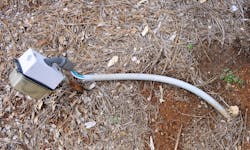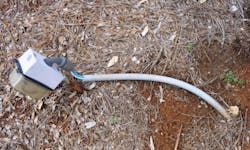How well do you know the Code? Think you can spot violations the original installer either ignored or couldn't identify? Here's your chance to moonlight as an electrical inspector and second-guess someone else's work from the safety of your living room or office. It's your turn to identify the violation. Note: Submitted comments must include specific references from the 2011 NEC.
Hint: Lack of protection
Find the Answer
Here's one of many similar installations I recently saw at an outdoor shopping mall. The wiring methods used here do not meet the following Code rules.
As per part of 356.10, liquidtight flexible nonmetallic conduit (LFNC)shallbepermittedinexposed orconcealedlocations wherelistedandmarkedassuitableforthepurpose or for direct burial where listed and marked for the purpose.
LFNC shall not be used where subject to physical damage (356.12).
"Ferrous or nonferrous EMT, elbows, couplings, and fittings shall be permitted to be installed in concrete, indirect contact with the earth, or in areas subject to severe corrosive influences where protected by corrosion protection and approved as suitable for the condition." (358.10)
Enclosures within the scope of Art. 314 shall be supported in accordance with one or more of the provisions outlined in 314.23(A) through (H). More specifically, "An enclosure that contains a device(s), other than splicing devices, or supports a luminaire(s), lampholder, or other equipment and is supported by entering raceways shall not exceed 1,650 cm3 (100 in.3) in size. It shall have threaded entries or have hubs identified for the purpose. It shall be supported by two or more conduits threaded wrench tight into the enclosure or hubs. Each conduit shall be secured within 450 mm (18 in.) of the enclosure." [314.23(F)]
> Try Another QuizAbout the Author
Joe Tedesco
Tedesco served the industry in many roles during his career. He was a director, senior electrical code instructor for National Technology Transfer, Inc. and American Trainco, Inc.. He was also a codes, standards and seminar specialist for the International Association of Electrical Inspectors and an electrical field service specialist for the National Fire Protection Association in Quincy, Mass. He ran his own business as an NEC consultant and is a Massachusetts licensed master electrician and journeyman electrician and certified electrical inspector (one and two family 2A; General 2B, and Plan Review, 2C). Tedesco also wrote articles for CEE News and EC&M (Code Violations Illustrated and What's Wrong Here?) for more than 15 years and helped launched the Moving Violations video series.

